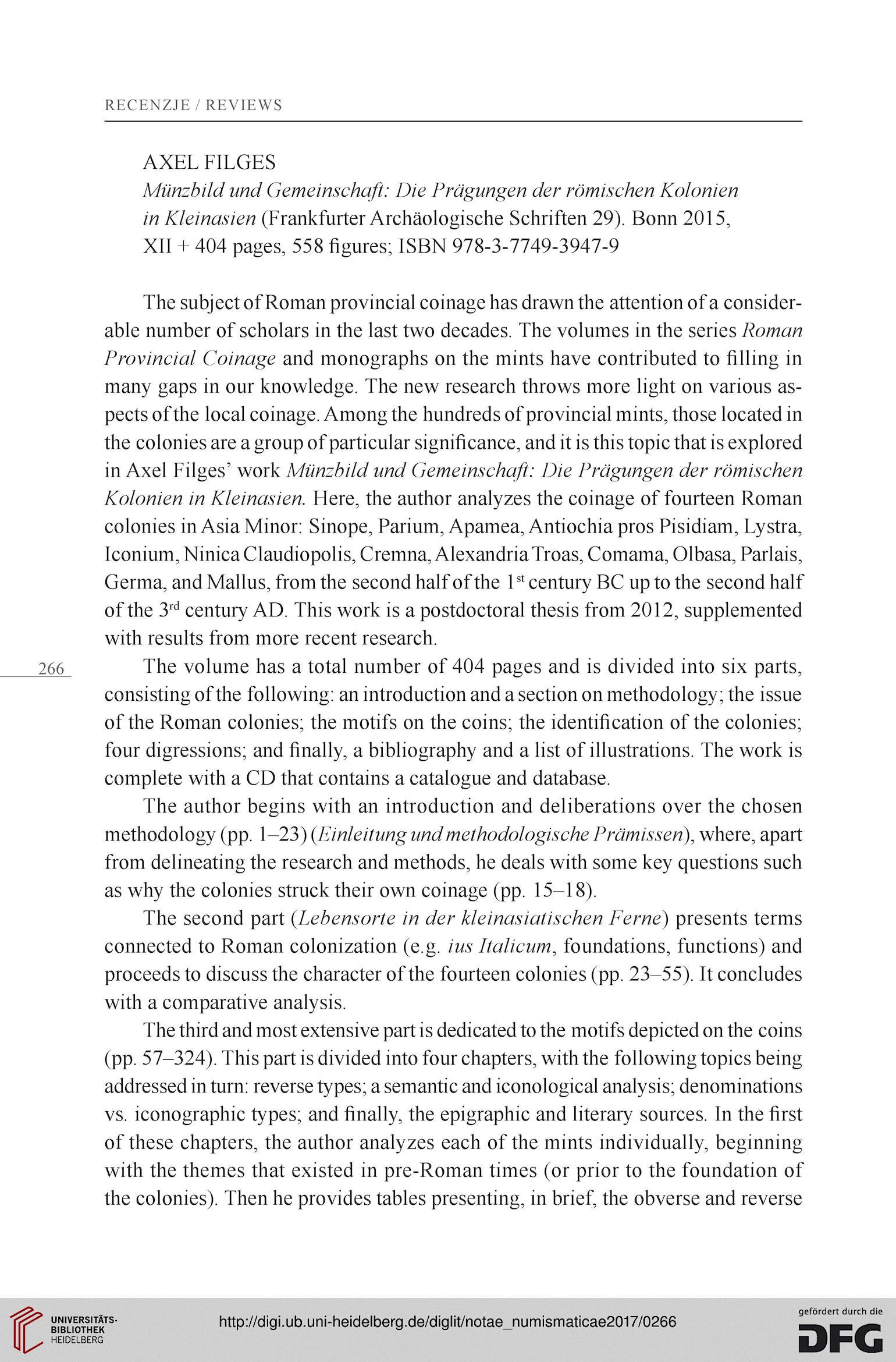RECENZJE / REVIEWS
266
AXEL FILGES
Münzbild und Gemeinschaft: Die Prägungen der römischen Kolonien
in Kleinasien (Frankfurter Archäologische Schriften 29). Bonn 2015,
XII + 404 pages, 558 figures; ISBN 978-3-7749-3947-9
The subject of Roman provincial coinage has drawn the attention of a consider-
able number of scholars in the last two decades. The volumes in the series Roman
Provincial Coinage and monographs on the mints have contributed to filling in
many gaps in our knowledge. The new research throws more light on various as-
pects of the local coinage. Among the hundreds of provincial mints, those located in
the colonies are a group of particular significance, and it is this topie that is explored
in Axel Filges’ work Münzbild und Gemeinschaft: Die Prägungen der römischen
Kolonien in Kleinasien. Here, the author analyzes the coinage of fourteen Roman
colonies in Asia Minor: Sinope, Parium, Apamea, Antiochia pros Pisidiam, Lystra,
Iconium,NinicaClaudiopolis, Cremna, Alexandria Troas, Comama, Olbasa, Pariais,
Germa, and Mallus, from the second half of the 1st Century BC up to the second half
of the 3rd Century AD. This work is a postdoctoral thesis from 2012, supplemented
with results from more recent research.
The volume has a total number of 404 pages and is divided into six parts,
consisting of the following: an introduction and a section on methodology; the issue
of the Roman colonies; the motifs on the coins; the identification of the colonies;
four digressions; and finally, a bibliography and a list of illustrations. The work is
complete with a CD that contains a catalogue and database.
The author begins with an introduction and deliberations over the chosen
methodology (pp. 1-23) (Einleitung und methodologische Prämissen), where, apart
from delineating the research and methods, he deals with some key questions such
as why the colonies struck their own coinage (pp. 15-18).
The second part (Lebensorte in der kleinasiatischen Ferne) presents terms
connected to Roman colonization (e.g. ius Italicum, foundations, functions) and
proceeds to discuss the character of the fourteen colonies (pp. 23-55). It concludes
with a comparative analysis.
The third and most extensive part is dedicated to the motifs depicted on the coins
(pp. 57-324). This part is divided into four chapters, with the following topics being
addressed in turn: reverse types; a semantic and iconological analysis; denominations
vs. iconographic types; and finally, the epigraphic and literary sources. In the first
of these chapters, the author analyzes each of the mints individually, beginning
with the themes that existed in pre-Roman times (or prior to the foundation of
the colonies). Then he provides tables presenting, in brief, the obverse and reverse
266
AXEL FILGES
Münzbild und Gemeinschaft: Die Prägungen der römischen Kolonien
in Kleinasien (Frankfurter Archäologische Schriften 29). Bonn 2015,
XII + 404 pages, 558 figures; ISBN 978-3-7749-3947-9
The subject of Roman provincial coinage has drawn the attention of a consider-
able number of scholars in the last two decades. The volumes in the series Roman
Provincial Coinage and monographs on the mints have contributed to filling in
many gaps in our knowledge. The new research throws more light on various as-
pects of the local coinage. Among the hundreds of provincial mints, those located in
the colonies are a group of particular significance, and it is this topie that is explored
in Axel Filges’ work Münzbild und Gemeinschaft: Die Prägungen der römischen
Kolonien in Kleinasien. Here, the author analyzes the coinage of fourteen Roman
colonies in Asia Minor: Sinope, Parium, Apamea, Antiochia pros Pisidiam, Lystra,
Iconium,NinicaClaudiopolis, Cremna, Alexandria Troas, Comama, Olbasa, Pariais,
Germa, and Mallus, from the second half of the 1st Century BC up to the second half
of the 3rd Century AD. This work is a postdoctoral thesis from 2012, supplemented
with results from more recent research.
The volume has a total number of 404 pages and is divided into six parts,
consisting of the following: an introduction and a section on methodology; the issue
of the Roman colonies; the motifs on the coins; the identification of the colonies;
four digressions; and finally, a bibliography and a list of illustrations. The work is
complete with a CD that contains a catalogue and database.
The author begins with an introduction and deliberations over the chosen
methodology (pp. 1-23) (Einleitung und methodologische Prämissen), where, apart
from delineating the research and methods, he deals with some key questions such
as why the colonies struck their own coinage (pp. 15-18).
The second part (Lebensorte in der kleinasiatischen Ferne) presents terms
connected to Roman colonization (e.g. ius Italicum, foundations, functions) and
proceeds to discuss the character of the fourteen colonies (pp. 23-55). It concludes
with a comparative analysis.
The third and most extensive part is dedicated to the motifs depicted on the coins
(pp. 57-324). This part is divided into four chapters, with the following topics being
addressed in turn: reverse types; a semantic and iconological analysis; denominations
vs. iconographic types; and finally, the epigraphic and literary sources. In the first
of these chapters, the author analyzes each of the mints individually, beginning
with the themes that existed in pre-Roman times (or prior to the foundation of
the colonies). Then he provides tables presenting, in brief, the obverse and reverse




